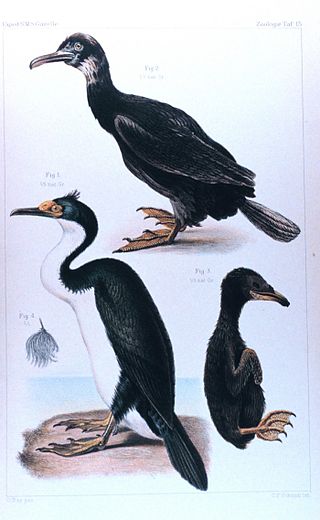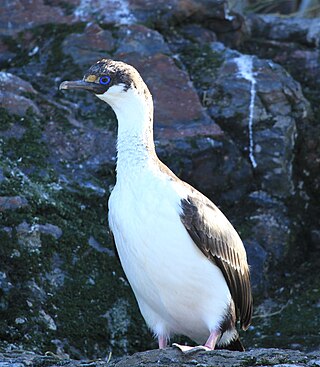
Phalacrocoracidae is a family of approximately 40 species of aquatic birds commonly known as cormorants and shags. Several different classifications of the family have been proposed, but in 2021 the International Ornithologists' Union (IOU) adopted a consensus taxonomy of seven genera. The great cormorant and the common shag are the only two species of the family commonly encountered in Britain and Ireland and "cormorant" and "shag" appellations have been later assigned to different species in the family somewhat haphazardly.

The European shag or common shag is a species of cormorant. It is the only member of the monotypic genus Gulosus. It breeds around the rocky coasts of western and southern Europe, southwest Asia and north Africa, mainly wintering in its breeding range except for the northernmost birds. In Britain this seabird is usually referred to as simply the shag. The scientific genus name derives from the Latin for glutton. The species name aristotelis commemorates the Greek philosopher Aristotle.

The spotted shag or pārekareka is a species of cormorant endemic to New Zealand. Though originally classified as Phalacrocorax punctatus, it is sufficiently different in appearance from typical members of that genus that for a time it was placed in a separate genus, Stictocarbo, along with a similar species, the Pitt shag. Subsequent genetic studies show that the spotted shag's lineage is nested within the typical shags.

The Otago shag, together with the Foveaux shag formerly known as the Stewart Island shag and in its dark phase as the bronze shag, is a species of shag now found only in coastal Otago, New Zealand.

The guanay cormorant or guanay shag is a member of the cormorant family found on the Pacific coast of Peru and northern Chile. After breeding it spreads south to southern parts of Chile and north to Ecuador, and has also been recorded as far north as Panama and Colombia – probably a result of mass dispersal due to food shortage in El Niño years. Its major habitats include shallow seawater and rocky shores.

The Cape cormorant or Cape shag is a bird endemic to the southwestern coasts of Africa.

The rock shag, also known as the Magellanic cormorant, is a marine cormorant found around the southernmost coasts of South America. Its breeding range is from around Valdivia, Chile, south to Cape Horn and Tierra del Fuego, and north to Punta Tombo in Argentina. In winter it is seen further north, with individuals reaching as far as Santiago, Chile on the west coast and Uruguay on the east. The birds also breed around the coasts of the Falkland Islands.

The New Zealand king shag, also known as the rough-faced shag, king shag or kawau tūī, is a rare bird endemic to New Zealand. Some taxonomic authorities, including the International Ornithologists' Union, place this species in the genus Leucocarbo. Others place it in the genus Phalacrocorax.

The black-faced cormorant, also known as the black-faced shag, is a medium-sized member of the cormorant family. Upperparts, including facial skin and bill, are black, with white underparts. It is endemic to coastal regions of southern Australia.

The imperial shag or imperial cormorant is a black and white cormorant native to southern South America, primarily in rocky coastal regions, but locally also at large inland lakes. Some taxonomic authorities, including the International Ornithologists' Union, place it in the genus Leucocarbo, others in the genus Phalacrocorax. It is also known as the blue-eyed shag, blue-eyed cormorant and by many other names, and is one of a larger group of cormorants called blue-eyed shags. The taxonomy is very complex, and several former subspecies are often considered separate species.

The Campbell shag, also known as the Campbell Island shag, is a species of bird in the family Phalacrocoracidae. It is endemic to Campbell Island. Its natural habitats are open seas and rocky shores. It is a medium-sized bird, around 63 cm in length, with a wingspan of 105 cm, weighing between 1.6 – 2 kg. They only breed on Campbell Island and forage within 10 km of the island. Its unique, looped head and elongated beak allows to easily feed on shellfish and marine invertebrates. This is done through foraging dive cycles of high speed and efficiency.

The Chatham shag, also known as the Chatham Island shag, is a species of bird in the cormorant and shag family, Phalacrocoracidae. It is endemic to the Chatham Islands of New Zealand. For a long time the species was placed in the genus Phalacrocorax; today it is mostly placed with the other blue-eyed shags of New Zealand and Antarctica in the genus Leucocarbo. Its closest relative is the Otago shag of South Island.

The Bounty shag, also known as the Bounty Island shag, is a species of cormorant of the family Phalacrocoracidae. They are found only on the tiny and remote Subantarctic Bounty Islands, 670 km (420 mi) southeast of New Zealand. Its natural habitats are open seas and rocky shores. In 2022, a full Unmanned aerial vehicle survey of the Bounty archipelago found a total of 573 breeding pairs and estimates the population to consist of approximately 1,733 birds. These recent estimates are consistent with the only other comparable study from 1978 and suggest that the species' population has remained stable over the past 45 years.

The Kerguelen shag is a species of cormorant endemic to the Kerguelen Islands in the southern Indian Ocean, one of the most isolated places on Earth. Many authorities consider it a subspecies of the imperial shag.

The South Georgia shag, also known as the South Georgia cormorant, is a marine cormorant native to South Georgia and a few other subantarctic islands in the South Atlantic Ocean.

The Macquarie shag, Macquarie Island shag or Macquarie Island cormorant, is a marine cormorant native to Macquarie Island in the Southern Ocean, about halfway between Australia and Antarctica.

The order Suliformes is an order recognised by the International Ornithologist's Union. In regard to the recent evidence that the traditional Pelecaniformes is polyphyletic, it has been suggested that the group be divided to reflect the true evolutionary relationships, a 2017 study indicated that they are most closely related to Otidiformes (bustards) and Ciconiiformes (storks).

The Crozet shag, also known as the South Georgia cormorant, is a marine cormorant native to the Crozet, Prince Edward and Marion islands in the South Atlantic Ocean.
Stewart Island shag or Stewart shag was the former name of a species of cormorant that was split into two species as a result of genetic studies. The two resulting species are:



















